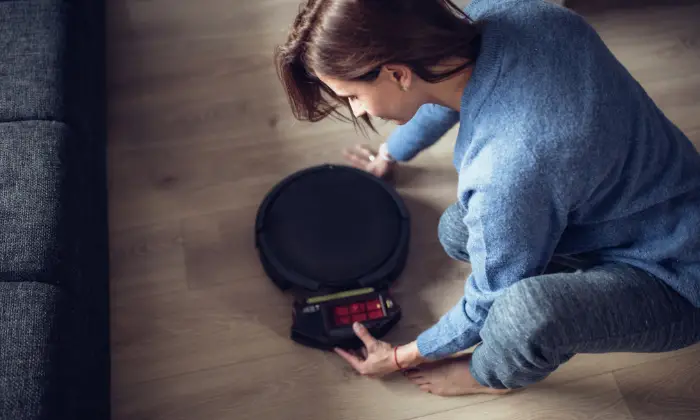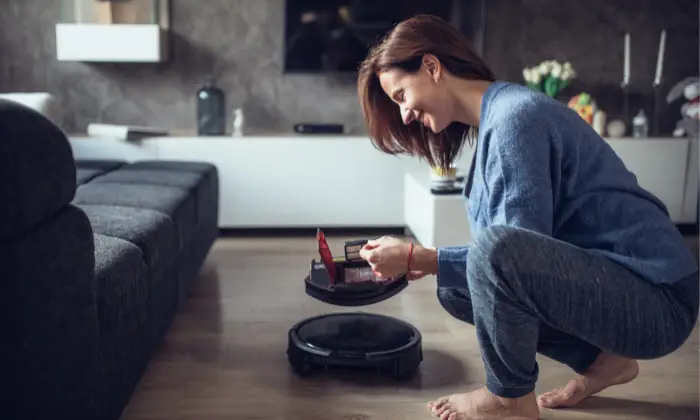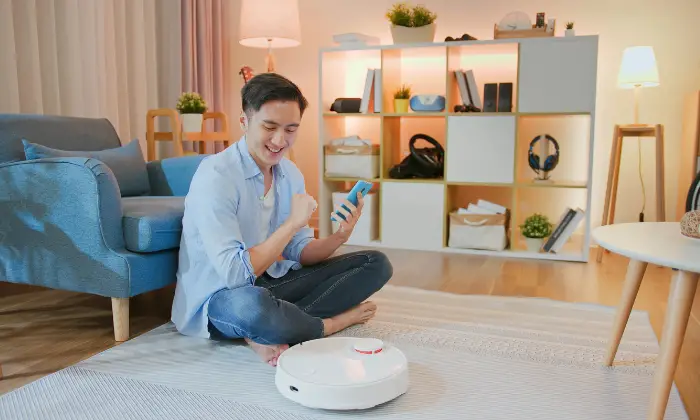
Disposing of a robotic vacuum can be daunting, but some simple steps will help make the task easier. Firstly, always keep in mind to protect yourself and others from potential injuries. Secondly, follow the specific instructions provided below for properly cleaning and disposing of your robot vacuum.
This article/blog will guide you on How to Dispose of a robotic vacuum and give you proper disposal notes to do it. Read On.
What is a robotic vacuum?
As wiki says, “A robotic vacuum, popularly known as a robovac or roomba as a generic trademark, is also known as an autonomous robotic vacuum cleaner, which has limited vacuum floor cleaning system combined with sensors & robotic drives with programmable controllers & cleaning routines.”
The robotic vacuum has low noise and automated cleaning sensors in small rooms or areas. You can control it with modern apps and smartphones. So, we can say that robotic vacuums are modern smart devices.

A robotic vacuum cleaner is a household appliance that uses suction to clean floors and surfaces. They are becoming increasingly popular, especially among families who have pets or allergy concerns. Unlike traditional vacuum cleaners, they are not plugged into an outlet, so you can move them around the room as needed.
When it’s time to dispose of your robotic vacuum, follow these simple steps to avoid any hassles. And don’t forget to recycle your robotic vacuum when the time comes!
How does a robotic vacuum work?
When you turn on a robotic vacuum, the app or device controlling it will ask if you want to use mapping or room scanning. If you choose room scanning, the robot will move around the room and map its surroundings. The vacuum uses this information to know where to clean next.
If you opt for mapping, your robot vacuum won’t move at all and instead uses a barcode scanner that sends data about rooms occupied by furniture and objects into the control center of your robot vacuum cleaner.
Either way, once mapping has been completed, your robot vacuum can commence cleaning without further input from you.
How to dispose of a robotic vacuum (Steps)

Disposing a robotic vacuum can be done in one of two ways: through the recycling bin or the garbage disposal. Some models even include an onboard dustbin for easy removal.
We will focus on the disposal options below for convenience, but always consult your local recycling center about recycling or How to Dispose of a robotic vacuum.
It’s time to say goodbye to your robotic vacuum cleaner! Here are 5 steps on How to Dispose of a robotic vacuum properly.
1. Get the vacuum cleaned
If you’re disposing of a robotic vacuum used at least once, it’s best to get it cleaned first. Remove all the dust and dirt from its body and brush any residual debris off the filters. If possible, clean upholstery, too – a dirty robotic vacuum can leave spots on furniture that will be difficult to remove later
2. Unplug the vacuum
Ensure to unplug your vacuum before you begin the disposal process. Dangerous electrical currents can still flow while the unit is in use and could cause damage to both it and any nearby electronics.
3. Remove the battery and screws
Remove the battery and screws if your vacuum includes them. This will allow you to recycle or dispose of the vacuum cleaner more environmentally friendly way. Depending on the model, these components may also be recyclable.
4. Take off the top of the robot & Separate the robot parts
With a few exceptions, all robotic vacuum cleaners have a removable top that can be unstuck and removed. Once it’s free, carefully remove the dustbin and other internal components.
Once you’ve freed all the parts, it’s time to separate them into their respective categories: robot body, vacuum cleaner head (or suction cups), electric cord, and battery. You’ll also want to note any serial numbers or other identifying marks on these items. If you have more than one robot vacuum Cleaning Robot Parts disposal is a breeze!
5. Destroy or recycle the vacuum cleaner
The vacuum cleaner head and electric cord should both be destroyed or recycled to prevent them from being reused. The battery should be disposed of safely and environmentally friendly through recycling or landfilling.
Disposal Notices:
If you want to get rid of robot vacuum, do the following:
• Ensure your robot vacuum is not attached to any power source.
• Remove batteries by unscrewing the battery covers and unplugging them.
• Take the robot vacuum to a waste management electronics recycling facility.
• Go to your school, workplace, or nearest waste management battery recycling facility and drop off the batteries.
• Under no circumstances should the batteries come into contact with metal.
Battery Notes:
- Place the batteries in a plastic bag and dispose of them following all applicable federal, state, and local restrictions if they leak due to overheating or physical abuse.
- Follow the battery removal procedure outlined above.
- Before installing new batteries, wipe the battery compartments in the vacuum with a damp cloth and allow them to dry.
How often do you have to dump the robot vacuum?
This is a difficult question to answer. Disposal of a robotic vacuum may vary depending on the model and manufacturer, so please consult your specific instructions or warranty booklet. In general, however, you should expect to dump your robot vacuum every 3–6 years if it’s used typically. It is sometimes preferable to acquire a newer model with superior suction power to keep your area dart-free regularly. For more information about roomba or iRobot model specials, simply check out amazon or eBay.
Should You Recycle or Repair your robot vacuum?

Recycling or repairing a robotic vacuum is up to you. However, if you choose to repair your robot vacuum, be sure to do so safely and responsibly. Follow all safety guidelines for electronics recycling facilities and dispose of the improved machine in the same manner as a brand-new unit.
What are the advantages of using a robotic vacuum compared to traditional vacuum cleaners?

There are a few key advantages to using a robotic vacuum cleaner over traditional ones.
Firstly, they’re much more portable and can be moved around the room as needed. This makes them great for small spaces or areas that might be difficult or impossible to clean with a regular vacuum cleaner.
Secondly, they’re less noisy than regular vacuums, so you can use them in bedrooms or other places where people sleep soundly without fear of waking up.
Finally, most robotic vacuums come with the app or device controls that make it easy to schedule cleaning and track the progress of your cleanings.
Related Queries from google:
Can you throw away a Roomba?
You should get a robotic vacuum compliant with local laws and regulations. Once you have purchased the vacuum, unplug it when it’s not in use and dispose of the batteries correctly. If you want to recycle your Roomba, you can take it to an authorized recycling center or put it in the trash.
What can you do with your used or old vacuum cleaner?
If you have an old vacuum cleaner that is no longer working or is in a state of disrepair, there are a few simple things you can do with it. You can break down the vacuum cleaner into component parts for recycling purposes and sell them as recycling materials. For example, you can sell the bag, belt, dustbin, motor, and blades separately. If the vacuum cleaner is not working or is past its prime, you can donate it to charity or dump it in a landfill.
How often do you have to dump the robot vacuum?
It would be best if you dumped your robot vacuum every 3 -6 years to keep it clean and healthy. Do not use the same bin for robotic vacuums of different brands, as this can create dangerous clogs. Use a particular filter cartridge you buy from the store to avoid any debris build-up inside the unit.
Are robot vacuums a gimmick?

There is no doubt that robotic vacuums are one of the most popular household appliances in recent years. While owning one has some downsides (mainly its price), these machines can do wonders for your home. Here is discussion of step by step guide on – how to dispose of a robotic vacuum. Reading our full blog properly will give you detailed guidelines.
Why are people so obsessed with robotic vacuums?
There are several reasons why so many people are obsessed with robot vacuums. First of all, the technology behind robotic vacuums has come a long way in the past few years.
Today, several types of robots on the market can clean floors much more efficiently than regular vacuum cleaners. They’re also lighter and smaller, so you can move them around easier.
Furthermore, robotic vacuums are usually more affordable than regular vacuum cleaners. This means that you can switch to a robot vacuum if you’re tired of cleaning your floors with a heavy and expensive piece of equipment.
In addition to these benefits, robotic vacuums also have the potential to reduce your environmental impact. Regular vacuum cleaners release harmful chemicals into the air, and robot vacuums are powered by electricity rather than gasoline or diesel.
As a result, they’re less likely to produce run-off that pollutes waterways. So, if you’re searching for a convenient way to clean your floors without wasting time and energy, robotic vacuums may be the perfect solution for you.
Conclusion
If you’re thinking of getting a robotic vacuum, or have already got one and are wondering how to dispose of a robotic vacuum, then you’ve come to the right place! In this blog, we will walk you through each step of the disposal process, from choosing the right robotic vacuum to disposing of it properly.
Just ensure to read through the guide carefully and follow the instructions to the letter to avoid any unwanted problems. We hope you find these guidelines helpful and that you can finally rid yourself of that pesky robotic vacuum!











